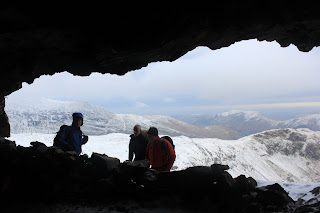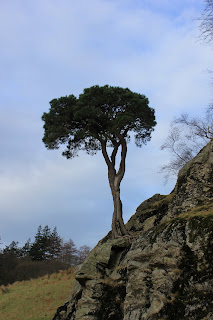Loweswater looking north from Watergate Farm track.
Striding out for Holme Wood, Burnbank our first fell in the background.
Although this looks cold there was little wind and the temperature was reasonable throughout the day so it was actually a pleasant walk. We were soon to pass the farm and turn left once through the gate heading through Holme Wood. Our only real obstacle here was a blown down tree blocking the path, which had not been there on two previous walks this year.
Holme Wood track slanting through to Holme Beck.
The hard climb over, walking to Burnbank summit.
It is an unremarkable summit yet as with the Mosser range, you get clear views of the Solway Plain, Robin Rigg windfarm(60) in the Solway Firth and on clearer less hazy days, of Scotland and The Isle of Man. A turn to the left and it was now a drop then shallower climb in iced peat to the cairn that is Blake Fell and the highest point of the walk at 573m. The views all around are wonderful but these fells, with the exception of Melbreak are peat paths in nature and if you are looking for a crag type scramble these first four do not fit the bill. They may also not be the biggest Wainwrights, but you have had a walk by the time you get to the end of this route. A gem of this fell is to move slightly to the west and take in the view of Congra Moss and Knock Murton Fell.
A frozen Congra Moss and Knock Murton Fell.
Whiteoak Moss, heading now for Hen Comb, Buttermere valley opening.
Melbreak with Grasmoor behind, seen from Hen Comb.
Once the food was in us we headed down and found the beck less of a challenge than our last outing where another colleague had ended up in the beck and not over it These are the challenges we take on, you can laugh about them months later, but they're not funny at the time. We pressed on for the saddle but it was here I was beginning to feel it in my legs; still the last real climb so it was a 'grit of the teeth' and a push for the top. Thankfully we made the saddle and the summit was to our far right. We knew this but it means we needed to then come back on ourselves. We took in the magnificent views of the Buttermere ranges from the summit though.
Looking back on Hen Comb from Melbreak's saddle.
Melbreak Summit, looking deep down Buttermere Valley, Fleetwith Pike in the far centre.
Left to right, Whiteside, Grasmoor and Whiteless Pike, taken from Melbreak.
Now the pub thankfully beckons and we retraced our steps and onto the more northern and 3m lower peak of Melbreak. Here once again the Solway Plain vistas opened but were overshadowed by the distant sight of The Kirkstyle Inn. We felt like the three wise men must have as Bethlehem came into view, as I'm sure there was a halo around the pub.
'Heaven' to the back right corner of the wood.
This had been an easy underfoot walk even in snow, but newcomers to it need to be aware here of a steep rocky and scree descent to Loweswater. In ice you get close to steep edges or can slip and keep sliding. Take time on this way down. If you drive down the Lorton Valley to do this walk, look at the right face of Melbreak, it is steep and that is where you will come down on this route, though there are lesser ways off..
Soon we were on the valley floor and walking toward the hamlet of Loweswater with it's pub and church. You can't avoid the purgatory of having to walk past The Kirkstyle Inn in order to get back to the car. Somehow we resisted and made the car. A 5hr walk of 17kms with 1150m ascent in powdery snow. A short hop in the car and three pints of Cumbrian Legendary Ales Pacific Voyage (Fletcher Christian is an infamous son of Cumberland and you look toward his old farm near Cockermouth) one each; the beer is served in rare to see measured pint glasses, absolute nectar of the Gods. This was washed down with an every bit as good, pint of Loweswater Gold and off we headed home. A days exercise and social meeting complete, nothing better.

























































